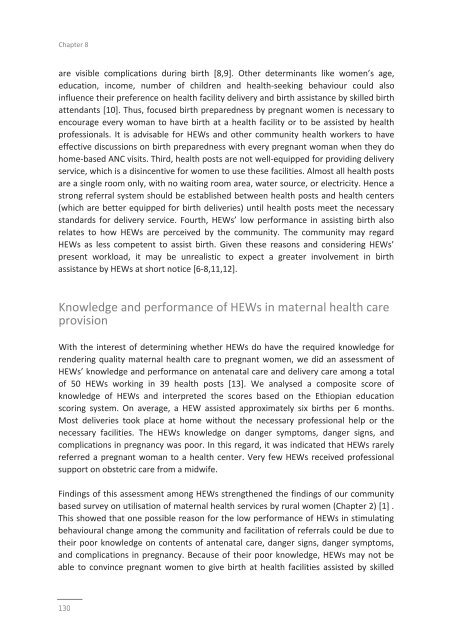araya-thesis
araya-thesis
araya-thesis
Create successful ePaper yourself
Turn your PDF publications into a flip-book with our unique Google optimized e-Paper software.
Chapter 8<br />
are visible complications during birth [8,9]. Other determinants like women’s age,<br />
education, income, number of children and health‐seeking behaviour could also<br />
influence their preference on health facility delivery and birth assistance by skilled birth<br />
attendants [10]. Thus, focused birth preparedness by pregnant women is necessary to<br />
encourage every woman to have birth at a health facility or to be assisted by health<br />
professionals. It is advisable for HEWs and other community health workers to have<br />
effective discussions on birth preparedness with every pregnant woman when they do<br />
home‐based ANC visits. Third, health posts are not well‐equipped for providing delivery<br />
service, which is a disincentive for women to use these facilities. Almost all health posts<br />
are a single room only, with no waiting room area, water source, or electricity. Hence a<br />
strong referral system should be established between health posts and health centers<br />
(which are better equipped for birth deliveries) until health posts meet the necessary<br />
standards for delivery service. Fourth, HEWs’ low performance in assisting birth also<br />
relates to how HEWs are perceived by the community. The community may regard<br />
HEWs as less competent to assist birth. Given these reasons and considering HEWs’<br />
present workload, it may be unrealistic to expect a greater involvement in birth<br />
assistance by HEWs at short notice [6‐8,11,12].<br />
Knowledge and performance of HEWs in maternal health care<br />
provision<br />
With the interest of determining whether HEWs do have the required knowledge for<br />
rendering quality maternal health care to pregnant women, we did an assessment of<br />
HEWs’ knowledge and performance on antenatal care and delivery care among a total<br />
of 50 HEWs working in 39 health posts [13]. We analysed a composite score of<br />
knowledge of HEWs and interpreted the scores based on the Ethiopian education<br />
scoring system. On average, a HEW assisted approximately six births per 6 months.<br />
Most deliveries took place at home without the necessary professional help or the<br />
necessary facilities. The HEWs knowledge on danger symptoms, danger signs, and<br />
complications in pregnancy was poor. In this regard, it was indicated that HEWs rarely<br />
referred a pregnant woman to a health center. Very few HEWs received professional<br />
support on obstetric care from a midwife.<br />
Findings of this assessment among HEWs strengthened the findings of our community<br />
based survey on utilisation of maternal health services by rural women (Chapter 2) [1] .<br />
This showed that one possible reason for the low performance of HEWs in stimulating<br />
behavioural change among the community and facilitation of referrals could be due to<br />
their poor knowledge on contents of antenatal care, danger signs, danger symptoms,<br />
and complications in pregnancy. Because of their poor knowledge, HEWs may not be<br />
able to convince pregnant women to give birth at health facilities assisted by skilled<br />
130


